Introduction to sheep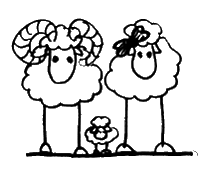
About sheep in general
Sheep belong to the Bovine family, sheep and goats subfamily. It’s one of our oldest and most widespread domesticated animals. They were domesticated approximately 10,000 years ago. The differences between the ancestors – different locations and climate, mixing the breeds, crossings, etc. – formed hundreds of breeds. At trials most frequently we can see sheep representing the Merino breed group or the ancient Hungarian breed, the Racka.
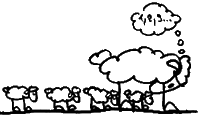 Sheep is a “follower” type social animal. From the first hour after birth, when they start to walk, the lambs start moving towards larger moving objects – generally towards their dam, and will follow them. Even adult animals will follow the people who used to feed them as lambs.
Sheep is a “follower” type social animal. From the first hour after birth, when they start to walk, the lambs start moving towards larger moving objects – generally towards their dam, and will follow them. Even adult animals will follow the people who used to feed them as lambs.

Sheep keep visual contact with at least one other animal. If they lose this contact, they immediately try to reestablish it. If this is not possible, they’ll bleat loudly and will intensely try to join up with other sheep.
A sheep kept segregated may bump into a human and could even knock down the person who separated it from the flock, so it’s advisable to watch them constantly. It’s expedient to keep the sheep in groups or in such a manner that they’d see each other so they do not get irritated by being isolated.

Sheep kept in a fenced-in area will learn how to react to a dog. The animals will scatter when attempting to herd them with a dog if they’re not used to that method of herding. The sheep flocked into one group will attempt to keep a minimal distance from the dog and react accordingly when the dog comes closer. The escape distance is kept both by a single sheep and a group. When they’re unable to escape, we can anticipate that they’ll face the dog or run by it as to avoid being rounded up.
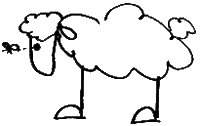 Sheep don’t perceive their environment like humans. Their eyes are located on the side of their head, thus they can see almost the whole space around them without having to turn their head. There is a “dead zone” of approximately 30 degrees behind them. Their field of three-dimensional vision which helps the depth perception is narrower than in humans.
Sheep don’t perceive their environment like humans. Their eyes are located on the side of their head, thus they can see almost the whole space around them without having to turn their head. There is a “dead zone” of approximately 30 degrees behind them. Their field of three-dimensional vision which helps the depth perception is narrower than in humans.
They have no sense of depth on their sides, they can sense only with either eye. This explains why they get scared when suddenly strange objects appear in their side field of vision. Originally the sheep is a prey animal, therefore they’re constantly watching their environment for danger – therefore a wide field of vision is very important. Although they react to a moving dog even from a distance of 1000 yards, they don’t react to a stationary one, because they don’t see it in detail as humans do.
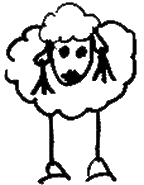 As we mentioned earlier, the domesticated sheep flocks as a result of the proximity of a dog or person. If this happens, it’s easier to herd them. It is much less difficult to move a flock than to separate a few sheep from it. However, a well-trained dog or two people will make separating them easier. Often it’s less difficult to herd the whole flock into a pen, even if we need only a few sheep.
As we mentioned earlier, the domesticated sheep flocks as a result of the proximity of a dog or person. If this happens, it’s easier to herd them. It is much less difficult to move a flock than to separate a few sheep from it. However, a well-trained dog or two people will make separating them easier. Often it’s less difficult to herd the whole flock into a pen, even if we need only a few sheep.
It’s easy to herd sheep with a dog or person due to the sheep’s attempt to keep the “escape” distance. A dog’s or a person’s position, body posture, movement and voice all influence the sheep’s reaction. During hot weather it’s advisable to start the work earlier as it’s easier to work with sheep during the cooler portion of the day – needless to say that this is better for the shepherds as well.
In order for the dog to give its peak performance, and accomplish their best work, we have to train them, regularly work them and constantly direct them.
There is great danger in a bottleneck when the flock is driven through a narrow opening, for example in case of a sectioned grazing area, through a gate. The risk can be reduced by the following:
- we let the sheep proceed at their own pace
- we utilize the terrain
- we put a person next to the opening to prevent the bottleneck
- we have to be more aware if a river, canal, gate or any other narrow object crosses the flock’s path.
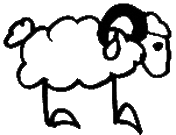 When we drive the flock to a gate, it’s necessary to stop the stress-inducing influences the dog and the noise is causing. Sheep need to see where they are going. To what extent it’s easy or difficult to drive the stock into the pen, largely depends on the location of the fences, gates and roads. It’s best if it’s not necessary to change directions abruptly, therefore the corners have to be rounded.
When we drive the flock to a gate, it’s necessary to stop the stress-inducing influences the dog and the noise is causing. Sheep need to see where they are going. To what extent it’s easy or difficult to drive the stock into the pen, largely depends on the location of the fences, gates and roads. It’s best if it’s not necessary to change directions abruptly, therefore the corners have to be rounded.
When we want to herd the flock into a small place, we need to accomplish the drive in the shortest possible time. The drive has to be successful at the first attempt, because if the sheep breaks out to the rear, it’d be that much harder to herd it back. It’s easier to herd them in if they see an area of at least 10 feet from the herding location. It’s simpler to herd if we flail or make noises from that spot. It’s effective, cheap and kinder to the animals to use audible signals while walking behind the stock. However, if we use these often, the animals will get used to them. When the effect of stress is significant, the sheep will press together and can climb on each other’s backs which can interfere with the smooth flow through openings. As soon as the sheep start to move through, we have to hold back with the driving and we have to let them “go like sheep”.
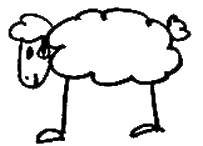 When we herd sheep on a public road, we have to pay more attention and stop the traffic. A more experienced person should go behind the flock to assist with the crossing more effectively and accurately.
When we herd sheep on a public road, we have to pay more attention and stop the traffic. A more experienced person should go behind the flock to assist with the crossing more effectively and accurately.
As sheep is a “follower” animal, naturally it’ll follow the others. It’ll follow a person if we got it accustomed to that. In many cases this method is effective in larger sheep farms, by utilizing an older, trained wether.
Characteristics of the sheep’s movement:
- moves faster on flat terrain than up a mountain, faster up a hill than down the hill
- generally stops and assesses the changes in the environment, when gets in front of a moving group
- as soon as it stops, it looks down at the ground to see whether it has enough room to move its head
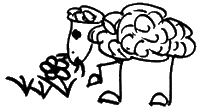 - turns back from the edge of a depression
- turns back from the edge of a depression
- rears if it sees a depression underneath
- it stops at a dead end, turns around and will retreat approximately 3 yards from the end.
- it refuses to go in deep water or when it can’t gauge the depth
- in the process of escaping they attempt to squeeze into openings narrower than their body
- doesn’t willingly go through unfamiliar narrow obstacles where they can’t see the end. It’s basically seeking an escape route when the dog herds it into this place and if it can’t see in, it rather won’t go in.
Sheep breeds prevalent in Hungary
Click here for information about the other domestic sheep breeds of the world.











